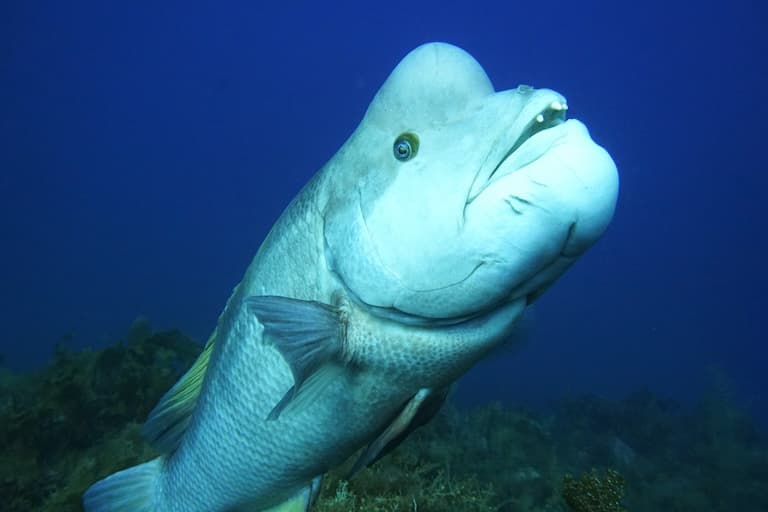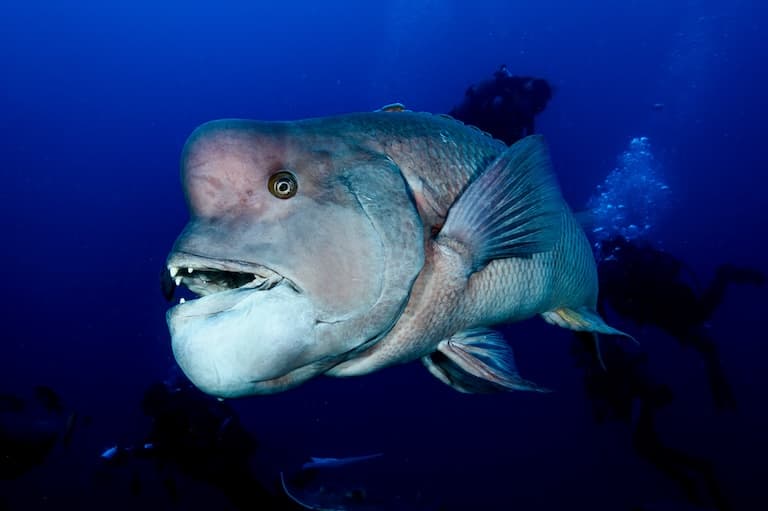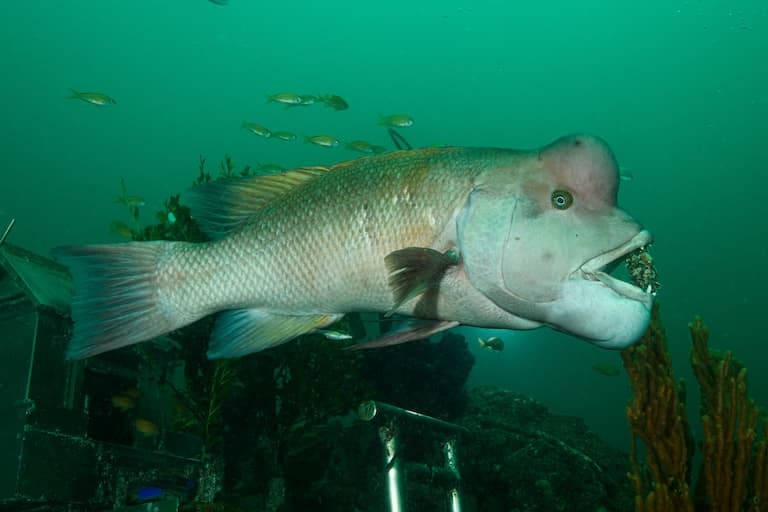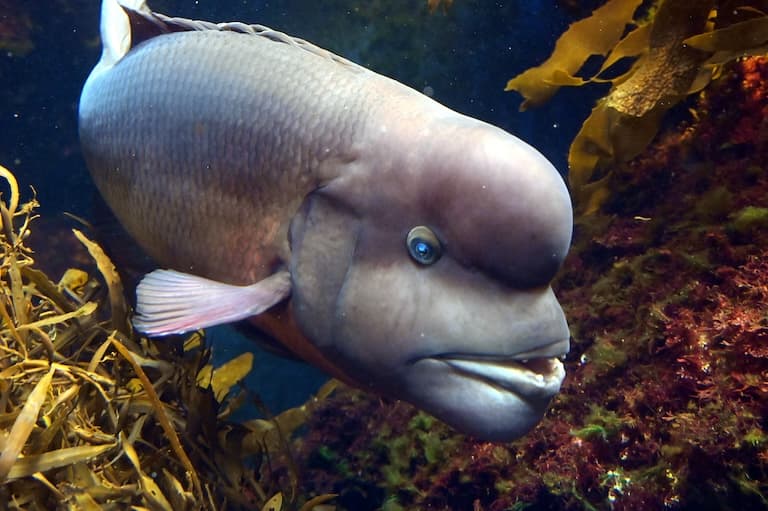Asian Sheepshead Wrasse Profile
14th-century Europe was a rough place. There was that plague, nobody had smartphones, and mathematical perspective in art wouldn’t be figured out for a hundred years or so.
So, when gallant explorers returned from adventures in the Orient, they would have to hire painters or whatever you call tapestry makers to make sense of some of the confusing animals they had seen out there.
In 1350, Jacob van Maerlant published Der naturen bloeme, or The Flower of Nature. This 13-book collection is perhaps the greatest work of naturalist gibberish to come out of 1350, and included giants with parasol feet, cyclopes and animals that do exist but look nothing like their pictures.
Thankfully, with modern cameras, it is not entirely unbelievable that there could be an animal as bizarre-looking as the sheepshead wrasse swimming about in the ocean. And yet, here it is.

Asian Sheepshead Wrasse Facts Overview
| Habitat: | Rocky reefs in temperate marine waters |
| Location: | Western Pacific: Japan, Korea, and China |
| Lifespan: | Up to 40 years |
| Size: | 1m (39 in) long |
| Weight: | 4.7 kg (32 lb) |
| Colour: | Weirdly pinky-grey |
| Diet: | Molluscs, crabs, and sea urchins, some fish, octopuses |
| Predators: | Few other than humans |
| Top Speed: | Not listed |
| No. of Species: | 1 |
| Conservation Status: | Data Deficient |
The Asian sheepshead wrasse looks like a mythological creature of the deep but it isn’t: it’s from the shallows.
And while the males look like bulbous alien eel monsters, the females look rather normal. Unfortunately for them, they will eventually turn into males and develop the mythological-tier ugliness that comes with it.
Interesting Asian Sheepshead Wrasse Facts
1. They’re Labrids
The Labridae family are quite diverse, with around 600 or more species known, and more than 80 genera. These are the wrasses, and they come in a variety of shapes and colours, usually quite small.
At the large end of the spectrum are the humphead wrasses, which can reach over 2.5 metres in length, so while the sheepshead wrasse is one of the largest there is at around one metre long, it’s not close to the top.
On the other hand, of the three species of sheepshead wrasse, the Asian sheepshead is the largest, and it holds other records, too. 1

2. They’re ugly
You’d think that the humphead wrasses would take the lead for ugliest wrasse, but it’s not even close.
More than 200 years after Maerlant’s fantastic encyclopaedia, another eccentric Dutch man wrote the Visboek: an encyclopaedia of fish.
This, too, contains some equally outrageous drawings, but knowing what we know about sheepshead wrasses now, they’re not as far out there as its predecessor.
This fish is one of the most distinctive in the ocean, with a large, bulbous head, beady eyes and peggy little teeth.
All of these are essentially a combination of sex-signalling features and fighting tools. Males defend territories with their big scary mouths and draw in females, who for some reason love the old Brothers Grimm Hag look.

3. They’re massively sexually dimorphic
And so, these features are very much a male characteristic, with the smaller females having a more standard fish-like appearance and nothing that would make you wonder if you’ve taken too much acid and fallen into a 14th Century explorer’s tapestry.
Unfortunately for them, though, they’ll become male themselves if they live long enough.
4. Sex changes on camera
This Channel 4 Documentary type behaviour was, fortunately, captured by BBC in an Attenborough production.
The wrasse in question flipped teams from the smaller, younger female, to an older, fatter male. In humans (and clownfish) this is usually the other way around and extremely rare. In fish, it’s actually a lot more common, with around 2% of species known to flip one way or the other.
And while the human sex changes are superficial, i.e., non-reproductive, for the wrasses it’s the real deal. In fact, it’s possible that all large male sheepshead wrasse seen swimming around bulbously were born female and transitioned as they reached a critical mass, both stages being fully capable of reproduction.
You may think this would wreak havoc on the marriage industry in wrasse communities but it turns out that they aren’t uptight about these things and they just don’t think it’s that big of a deal. Maybe there’s something profound to be learned from this, and there’s at least one diver who might be quite close. 2
5. Japanese men love them
Admittedly, this sweeping, clickbaity generalisation of around 65 million people extrapolates from a sample size of 1, so we will accept more data as it comes in.
An octogenarian diver from Japan known as Hiroyuki Arakawa has been visiting what he thinks is the same fish for around thirty years.
He met the wrasse when supervising the underwater construction of a temple gate, and the pair began to get familiar with one another. Not in a weird way, any more than it’s unusual for a man to befriend a fish, but what’s remarkable is that they appear to genuinely like one another.
This shouldn’t be surprising to anyone who’s studied fish, but since the vast majority of us haven’t, it is a bit of a novelty.
Fish are far more complex than their dopey, expressionless faces let on, and are capable of experiencing fear, pain, and even that acute embarrassment you get when you go the wrong way by mistake and then have to look at your phone and pretend your plans had changed so you don’t look like an idiot to any strangers watching you for some reason.
While enjoyable to poke fun at, this relationship should be a poignant reminder of the capacity for friendship between species and hopefully inspire at least some people to look at these animals with greater respect for them as non-human people. 3 4

6. Lots of people eat them
Sadly, this friendly fish is more commonly appreciated in a gustatory context and is prized for its shellfish-like meat in many countries.
It’s not clear how their populations are doing, because there doesn’t appear to be enough data available on the species for the IUCN to make a claim,
7. Mucous cocoons
If the thought of eating a wrasse is a lot more appealing than the thought of kissing one, perhaps mucous cocoons are the solution to this misalignment.
At night, after spending all day headbutting one another and eating German fairy-tale children who wandered too far into the woods, these incredible monsters wrap themselves up in a sheath of mucous to disguise their pheromones and hide them from predators.
Asian Sheepshead Wrasse Fact-File Summary
Scientific Classification
| Kingdom: | Animalia |
| Phylum: | Chordata |
| Class: | Actinopterygii |
| Order: | Labriformes |
| Family: | Labridae |
| Genus: | Semicossyphus |
| Species: | reticulatus |
Fact Sources & References
- Marloes Poortvlie (2013), “Phylogeography of the California sheephead, Semicossyphus pulcher: the role of deep reefs as stepping stones and pathways to antitropicality”, PubMed Central.
- BBC Earth (2021), “The Sex-Shifting Fish | Blue Planet II |”, BBC Earth.
- Franka Dervishi (2023), “This Japanese Diver Has Been Visiting His Best Friend Fish For 25 Years Now”, Bored Panda.
- Regina Sienra (2023), “Japanese Man Nurses Fish Back to Health and Remains Friend for Life”, My Modern Met.
